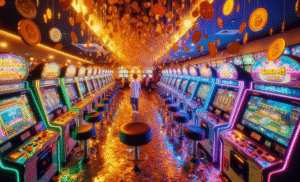How Much Money Is Typically Borrowed To Start A Game Machines?
How Much Money Is Typically Borrowed To Start A Game Machines? IntroductionThe high expenses of building a casino are driven by these several elements, which makes most entrepreneurs look for outside investment.
Usually, the size, location, and scope of a casino determine the amount of money one borrows to launch it.

Licencing And Regulatory Fees
Aspiring casino operators have to get the required licenses and follow rigorous legal rules even before building starts. Licensing fees by themselves could vary in various countries from several hundred thousand dollars to tens of millions. For example, the Nevada licensing process calls for background checks, financial audits, and payment of fees totaling millions of dollars.
Building ExpensesAmong the most major outlays in building a casino is construction. From luxurious hotel buildings to cutting-edge casino floors, developers have to extensively spend in architecture, engineering, and interior design. Depending on the location and facilities, a big casino building project may run anywhere from $500 million to over $3 billion.
Usually, long-term loans or a mix of debt and equity finance the great cost of building. Usually designed with interest-only payments during the development stage, construction loans change to become regular payback once the casino starts making money. Getting such loans hinges on showing to possible lenders a strong company plan and market analysis.
Technologies And Equipment For Gaming
The gaming floor of a casino calls for a large equipment and technological investment. Price tags abound on modern gaming machines, computerized table games, and surveillance equipment. Outfitting the gaming floor might run a midsize casino between $10 million and $20 million. Bigger casinos with hundreds of game choices may commit about $50 million.
Many times, equipment loans or lease agreements cover these expenses. By lowering upfront costs, leasing gaming equipment lets operators free more of their borrowed money for other facets of development. Still, leases could have more long-term expenses than straight purchases.
Pre-Opening Expenses And MarketingA casino has to engage in large-scale marketing activities even before the doors open in order to create hype and draw possible patrons. These costs comprise personnel hire, advertising, and promotional activities. Ten to fifteen percent of the entire budget can go into pre-opening expenses, therefore augmenting the financing needs by millions of dollars.
How Much Money Is Typically Borrowed Pre-opening costs
Pre-opening costs are sometimes seen by lenders as a necessary component of the investment since effective marketing campaigns can greatly affect the early income generating of a casino. Some developers get bridging loans especially to pay for these upfront marketing expenses.
Many casino developments start their financing mostly from commercial bank loans. Before authorizing loans often totaling hundreds of millions of dollars, banks evaluate the developer’s creditworthiness, predicted income, and collateral.
Large-scale projects may call for syndicated loans, in which several financial institutions combine resources to create one, large loan. Usually utilized for huge projects or integrated resorts, these loans can run for more than $1 billion.
Funding for private equity investments—that is, for a share in the earnings of the casino—may come from individuals or corporations. Particularly popular in high-profile initiatives with expected large returns is this approach.
Projections Of Revenue And Loan Repayment
When deciding loan terms, lenders take into account expected profits of a casino. With annual income in the hundreds of millions, a well-located casino with several revenue sources—including gaming, hospitality, and entertainment—can pay back loans rather fast. But depending on the terms, large-scale loans could have 10–20 year repayment times.
Managing loan rates—which vary with time—add another difficulty for developers. While variable-rate loans offer lower starting rates but run the danger of future hikes, fixed-rate loans offer stability but may have higher initial expenses.
Conclusion
Usually driven by project size, location, and market conditions, the amount of money borrowed to open a casino ranges greatly. While tiny venues could need loans in the tens of millions, big resorts typically find funding in the billions. To fulfill their financial needs, developers mix bank loans, private investments, and other sources; they then bring their ideas to life.
Starting a casino is a difficult and expensive project, but developers may negotiate the difficulties of borrowing and build profitable, revenue-generating businesses by means of rigorous financial planning and a solid awareness of market dynamics. Knowing the nuances of funding is the first step toward long-term success for individuals thinking about entering this sector.
